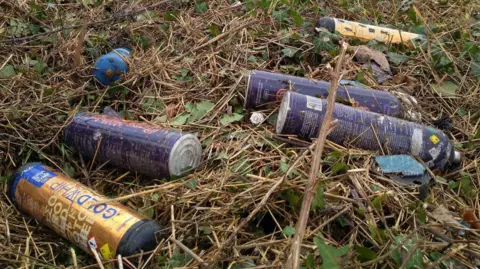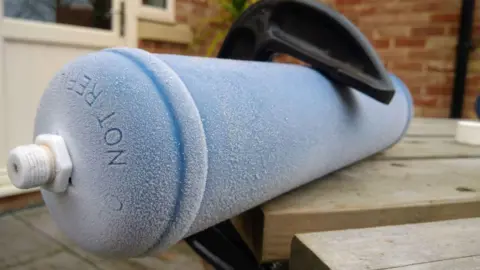Teacher collects 300 nitrous oxide cans in three months
 John Devine/BBC
John Devine/BBCA school teacher who has been collecting discarded nitrous oxide canisters blighting the verges of his local roads said he had amassed almost 300 in just three months.
Tim Chapman, from Wisbech, has been picking them off the roadsides in Cambridgeshire and Norfolk since November.
The 60-year-old keen cyclist decided to take action after being "fed-up" of seeing them littered everywhere, adding they could cause anyone on a bike to crash.
"Each canister is made of steel and weighs 1.4kg (3lb). In three months I have collected a third of a tonne," he said.
 Tim Chapman
Tim ChapmanUse of nitrous oxide, or laughing gas, soared during the Covid-19 pandemic - particularly among young people - which led to its ban for recreational purposes.
Nitrous oxide is now a Class C drug under the Misuse of Drugs Act 1971.
However, medical use of the gas is unaffected, and you can still buy large canisters as a propellant for whipped cream and other industrial uses.
 Tim Chapman
Tim ChapmanMr Chapman said he began collecting the canisters in mid-November, as he "got fed-up of seeing them at the side of the road where I cycle".
"They are dangerous because road users may hit them; a cyclist or motorcyclist could crash as a result. About 10% of them still have gas left inside too," he said.
Many canisters have been found along the A47 and on playing fields in Mr Chapman's hometown, as well as in several outlying villages.
 Tim Chapman
Tim Chapman"A single canister costs around £20 to buy online, but they are often bought in a box of six. Sometimes, two or three boxes of abandoned canisters are left by the wayside," he said.
Mr Chapman plans to sell the canisters for scrap, which would pay for the tools he has bought to dismantle them safely.
 Tim Chapman
Tim ChapmanThe canisters were too easy to purchase without checks, Mr Chapman said, particularly online.
"I am not sure how the problem can be solved - it is illegal to possess them for recreational use as a drug, the law has to be enforced," he said.
"The only thing that might work is having a deposit scheme on the canister that you get back when the empty is returned."
Under the law, those caught with nitrous oxide for unlawful use face a caution, community service or an unlimited fine.
Repeat offenders could serve up to two years in prison.
The maximum sentence for production or supply of the drug for unlawful purposes is 14 years.
Follow Cambridgeshire news on BBC Sounds, Facebook, Instagram and X.
